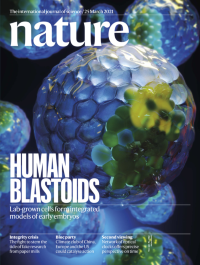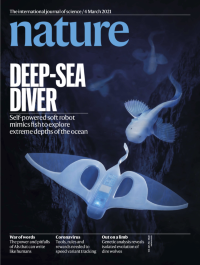Volume 591
-
No. 7851 25 March 2021
Human blastoidsOur understanding of early human embryonic development is hampered by the lack of suitable models. In this week’s issue, two papers seek to address this problem in the form of lab-grown cellular models of the human blastocyst — the ball of cells that forms within the first few days of embryo development. The two teams used different starting points: in one article, Jun Wu and his co-workers used human pluripotent cells, in the other, Jose Polo and his colleagues used adult fibroblasts undergoing reprogramming. Both groups were able to induce their respective cells to self-organize in a dish to form three-dimensional structures that resemble blastocysts. Both types of structure — named blastoids by Wu et al. and iBlastoids by Polo et al. — represent an integrated model of the early human embryo, although the teams note that their structures are not equivalent to human blastocysts. Nevertheless, the researchers believe that blastoids and iBlastoids will prove valuable in studies of infertility and pregnancy loss.
Focal Point
-
No. 7850 18 March 2021
The silicon soapboxArgument and debate are fundamental capabilities of human intelligence. In this week’s issue, Noam Slonim and his colleagues describe results from Project Debater, an artificial intelligence system that can engage in competitive debates with humans. The system can scan through an archive of 400 million newspaper articles to form opening statements and counter-arguments. The researchers tested their system over a range of topics, comparing it to various baselines as well as to human expert debaters. Although human experts still have the edge, Project Debater received high marks in its debates from a virtual audience of people, and the team says the results show that AI has the potential to participate in complex human activities.
Nature Index
-
No. 7849 11 March 2021
Flight of the falconLittle is known about what determines the migratory routes taken by birds in the Arctic. In this week’s issue, Xiangjiang Zhan and his colleagues examine the routes taken by the peregrine falcon (Falco peregrinus) as they move from breeding grounds in the Arctic to winter in various locations across Eurasia. The researchers combined satellite tracking data from 56 falcons with 35 resequenced genomes, and used palaeoclimate data to reconstruct breeding and wintering distributions in the past for the birds. They determined that the birds’ migration patterns have been primarily shaped by environmental change since the end of the Last Glacial Maximum (22,000 years ago). The team also identified a genetic component that might be helping the birds — falcons that migrated longer distances had a dominant genotype of the gene ADCY8, which the authors suggest could be associated with the development of long-term memory and so help preserve migration routes. The cover shows a falcon fitted with a GPS transmitter for tracking its movements.
-
No. 7848 4 March 2021
Deep-sea diverThe extreme conditions found in the deep sea mean that this part of the planet remains largely unexplored. In this week’s issue, Tiefeng Li and his colleagues present a soft robot that can operate at depths of nearly 11,000 metres. The design of their robot was inspired by the deep-sea snailfish (Pseudoliparis swirei). The robot’s various electronic components are distributed throughout its body and the whole is encased in a flexible silicone matrix that allows it to withstand extreme pressure. In tests, the team successfully operated the robot at depths of 3,224 metres below the surface of the South China Sea, and up to 10,900 metres in the Mariana Trench. The cover shows an artist’s impression of both robot and the snailfish that inspired it.




